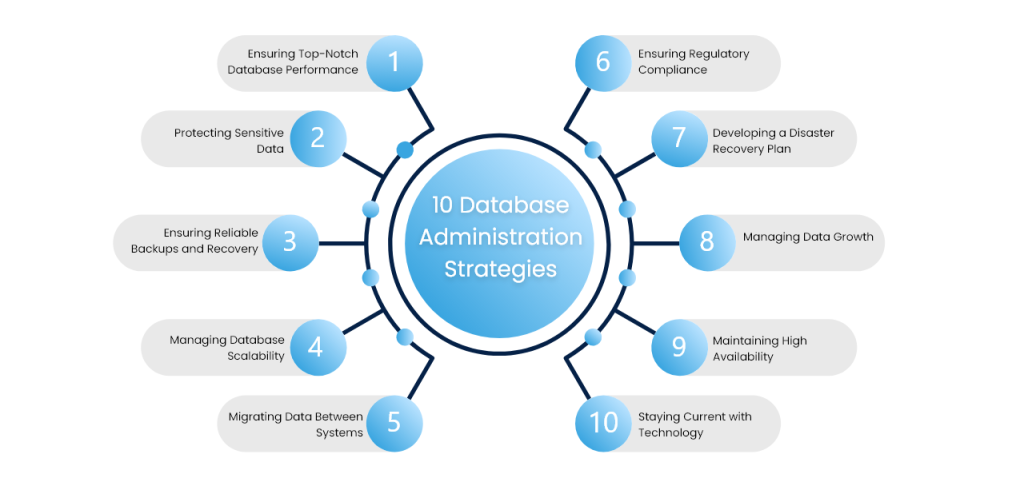Battle Plan for Top 10 Database Administration Headaches.

In our data-driven world, managing databases is crucial for any organization. However, database administrators (DBAs) face numerous headaches that can hurt a database’s performance, security, and reliability. Understanding and solving these challenges is essential for keeping database environments running smoothly. Let’s discuss the top 10 database administration headaches and provide practical solutions.
1. Ensuring Top-Notch Database Performance
One of the biggest headaches DBAs face is ensuring databases perform optimally. Sluggish performance leads to slow responses and frustrated users. To conquer this, DBAs should regularly monitor performance using tools to identify bottlenecks. Proper indexing and optimizing queries are also vital. Regularly reviewing and fine-tuning SQL queries can significantly boost performance. Analyzing query execution plans is helpful for pinpointing inefficiencies and reworking them.
Simple maintenance like updating statistics and defragmenting indexes shouldn’t be overlooked. Keeping the database schema organized and provisioning adequate hardware resources are other key steps for efficient databases.
Safeguarding sensitive data from prying eyes is paramount for DBAs. Implementing encryption for data at-rest and in-transit is crucial. Using role-based access controls to limit data access to only authorized personnel and conducting regular security audits helps identify and mitigate vulnerabilities. Data masking techniques can further protect sensitive info in non-production environments.
Adopting a robust security policy with regular patching and database software updates protects against known vulnerabilities. Using advanced measures like multi-factor authentication (MFA) and intrusion detection systems (IDS) enhances security posture.
3. Ensuring Reliable Backups and Recovery
Ensuring data can be quickly restored if disaster strikes is critical for business continuity. Scheduling automated regular backups avoids human errors. DBAs should also routinely test backup and recovery procedures to ensure they work as expected while maintaining backup copies in different locations for redundancy. Using incremental backups saves time and storage.
Implementing a solid backup strategy combining full, differential, and transaction log backups ensures data recovery is possible from various points in time. Storing backups off-site or in the cloud provides extra protection against local disasters. Documenting and updating backup/recovery procedures regularly ensures everyone is prepared to act swiftly in emergencies.
4. Managing Database Scalability
As organizations grow, so does the need for scalable databases to handle increasing data and user load. Horizontal scaling distributes load across multiple servers, while vertical scaling involves upgrading hardware. Shading, which partitions databases into smaller pieces, also helps manage scalability.
Implementing load balancing ensures no single server gets overloaded, preventing performance hits. Regularly reviewing and optimizing database architecture accommodates growth and prevents bottlenecks. Database clustering and replication distribute load and enhance overall resilience.

5. Migrating Data Between Systems
Migrating data between different databases or environments can be complex and risky. Developing a detailed migration plan with timelines and risk assessments is crucial. Thorough testing before, during, and after migration ensures everything works properly. Post-migration data validation confirms data integrity.
Using data migration tools streamlines the process and reduces errors. Ensuring dependencies and interconnections between old and new systems are well-understood and documented is key. Communicating with stakeholders throughout migration manages expectations and addresses issues promptly.
6. Ensuring Regulatory Compliance
DBAs must ensure databases comply with regulations like GDPR, HIPAA, and SOX. Implementing strict data policies, educating staff on requirements and best practices, and conducting regular compliance audits are essential for compliance.
Maintaining documentation of data handling processes and access controls is critical for audits. Using data anonymization further protects personal info where possible. Partnering with legal/compliance teams ensures practices remain compliant as regulations evolve.
7. Developing a Disaster Recovery Plan
Unexpected disasters can cause major data loss and downtime, making disaster recovery (DR) planning essential. Developing a comprehensive DR plan with detailed data recovery steps is crucial. Regularly update the plan and perform DR simulations to test effectiveness.
Incorporating redundant systems and failover mechanisms ensures data remains accessible during outages. Clearly defining roles and responsibilities within the DR plan ensures everyone knows their part. Investing in reliable DR infrastructure minimizes downtime and data loss.
Exponential data growth can lead to storage issues and performance hits. Implementing data archiving for old/infrequently accessed data, using compression to reduce storage needs, and regularly purging unnecessary data frees up space effectively.
Using tiered storage keeps frequently accessed data on high-performance storage while moving less critical data to cost-effective solutions. Automating data lifecycle management maintains optimal storage usage and performance.
9. Maintaining High Availability
Ensuring databases are always available is critical for uninterrupted operations. Database clustering and replication are effective high-availability strategies. Load balancing also distributes load evenly across servers to avoid downtime so users always have data access.
Implementing failover clusters and geographically distributed replicas further enhances availability. Regularly testing failover procedures and monitoring database node health ensures high availability setups function correctly.
10. Staying Current with Technology
Database technologies constantly evolve, so DBAs must stay updated to leverage new features and improvements. Continuous learning through courses, certifications, and conferences is essential. Participating in communities/forums and leveraging vendor resources keeps DBAs informed on trends and best practices.
Adopting AI/ML for database management tasks leads to more efficient operations. Proactively evaluating and implementing new tools/methodologies keeps environments competitive and secure.
Conclusion
Database administration is challenging yet rewarding, requiring constant vigilance, skill, and adaptability. By understanding and addressing these top 10 headaches, DBAs can ensure databases remain secure, performant, and reliable. Implementing these solutions overcomes challenges and paves the way for robust, efficient database environments – ultimately contributing to organizational success.
For organizations looking to enhance database administration, ESDS Software Solution offers comprehensive DBA services. Our expert team is well-equipped to handle headaches, providing top-notch support to keep your databases secure, efficient, and compliant. Partnering with us helps you stay ahead of issues and maintain smooth, efficient, secure database operations. Contact us to learn how we can support your needs.
- Strengthening BFSI Security Posture with SOAR Integration - June 27, 2025
- Security Operations Center (SOC) Services: A Measured Approach to Digital Threat Management - April 11, 2025
- The Impact of AI on Colocation Services - February 13, 2025
